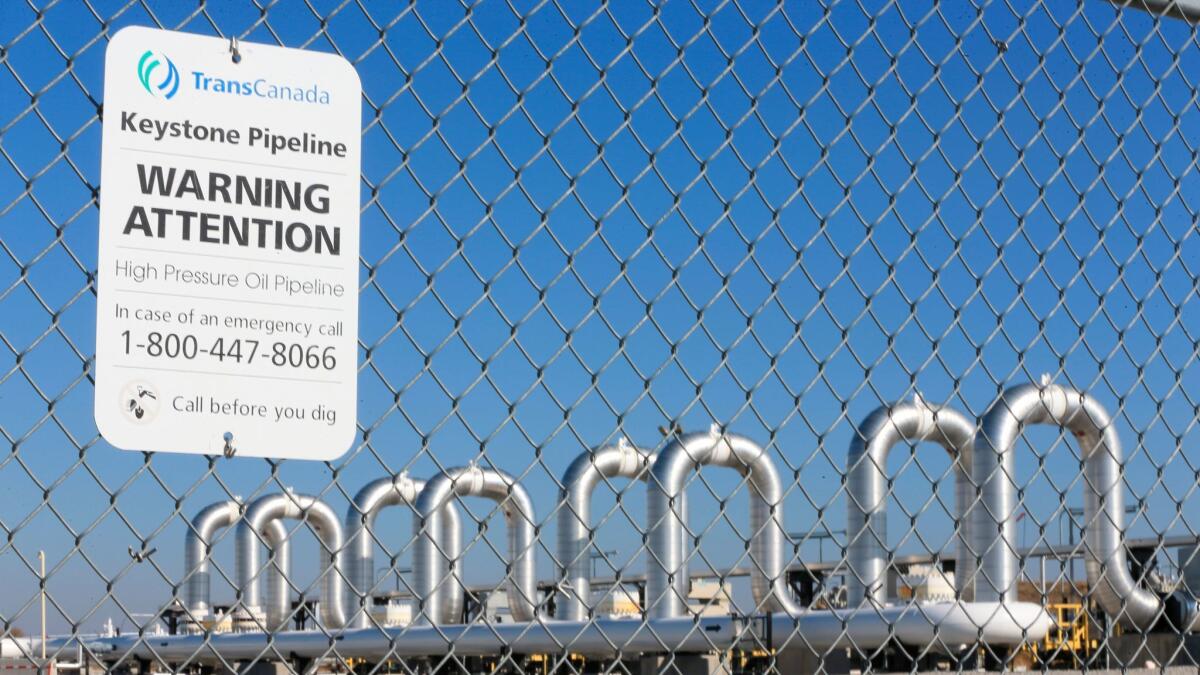Nebraska regulators have approved a new route for the Keystone XL pipeline. But will it ever be built?

The Nebraska Public Service Commission has authorized the controversial Keystone XL pipeline, but the decision — a new route with substantial environmental and legal impediments — now leaves serious questions about whether the $8-billion pipeline will ever be built.
“It’s a huge victory,” said Brian Jorde, an Omaha lawyer who represented 100 landowners who refused to sign leases to allow the pipeline to cross their property. “The commission sent TransCanada down a new, long and twisting road of appeals to get this pipeline built.”
Nebraska state Sen. Jim Smith, a Republican who strongly supported the project, was similarly skeptical about the pipeline’s prospects.
“This creates unnecessary uncertainty. Too bad,” he tweeted after the commission’s 3-2 vote Monday.
Russ Girling, TransCanada’s president and chief executive, who this month told a group of executives he was confident that the Keystone XL would attract strong interest from Alberta tar sands oil shippers when it was finished, was considerably more subdued on Monday.
“As a result of today’s decision, we will conduct a careful review of the Public Service Commission’s ruling while assessing how the decision would impact the cost and schedule of the project,” he said in a statement.
The commission’s decision was the latest twist in a story of a mega energy project that nine years ago breathed the pure economic oxygen of Alberta’s oil sands boom. The Keystone XL project, designed to transport 830,000 barrels of oil 1,179 miles from northern Canada to Steele City, Neb., is now gasping the thin air of low oil prices, slowing production, rising expenses, sinking demand and intense civic opposition.
Nearly from the moment that TransCanada introduced the pipeline in 2008, the Keystone XL has attracted outsize attention. Residents of Texas, where the pipeline was originally proposed to terminate, complained their land was being taken against their will. Nebraska residents resented what they said was unwelcome bullying by a foreign company. They feared oil spilled from Keystone XL would ruin their prime source of drinking water.
National environmental groups opposed the project on the grounds it would prod more tar sands development, the dirtiest source of oil, according to several authoritative studies, and pour millions more tons of carbon emissions into the atmosphere. President Obama, who was sympathetic to that view, rejected TransCanada’s application to cross the U.S. border in November 2015, the first time a head of state had ever relied on climate effects to turn away a big fossil-fuel development project.
Business executives and Republican leaders supported Keystone XL and had very different views of its value as a source of new jobs, property tax revenue and energy investment. In January, President Trump signed an executive order to reconsider TransCanada’s application. In March, the administration signed the construction permit. Earlier, Montana and South Dakota also had approved pipeline routes and issued TransCanada construction permits.
On Monday, in a packed hearing room in Lincoln, both sides awaited the Nebraska Public Service Commission’s crucial ruling, the last regulatory hurdle for the proposed project. During a proceeding that lasted less than 10 minutes, the commission’s three men overruled its two women and approved building the Keystone XL, but on a route much different than the one TransCanada preferred.
The so-called Mainline Alternative Route draws the XL closer to the alignment of the Keystone pipeline, its 7-year-old sister, which transports more than 500,000 barrels of Alberta tar sands oil daily to refinery hubs in Oklahoma and Illinois.
In its application to the commission, TransCanada specifically objected to the alternative route because it would be longer, require more pumping capacity and cost more. The new route also would require more environmental review because it would disturb more land and erodible soils, cross more habitat for threatened and endangered species, and cross more streams.
“For these reasons,” said the company, “the Keystone Mainline Alternative Route is not considered beneficial, nor is it preferable.”
The commission’s ruling initially perplexed observers. But soon after the hearing adjourned the full measure of its import became clear. If TransCanada wants to proceed, it faces years of additional state regulatory review and court proceedings.
Jorde, a veteran of Public Service Commission law and proceedings, said TransCanada had 30 days to appeal the ruling. That step would trigger 18 months to two years of appeals court oversight, and perhaps one more year of litigation before the state Supreme Court.
At least 40 new landowners have suddenly been drawn into the permit process. Some would be expected to resist TransCanada’s leasing offers and the company would need to file lengthy eminent domain cases against them. More than a third of the 275 landowners affected by the Keystone’s original route refused to sign land lease agreements with TransCanada.
One more impediment posed by the change in Nebraska’s pipeline route could prompt a new review in South Dakota. If Nebraska’s new route forces a change in the route in its neighbor state, the South Dakota Public Utilities Commission stipulated in its construction permit a requirement that TransCanada submit the change to a mandatory review.
“The Nebraska commission did TransCanada a favor,” Jorde said. “At the end of the day, TransCanada doesn’t want to build this pipeline. Now they can go to their shareholders and say the regulators made this project impossible to build. We can’t move forward. They can blame what happened here on someone else.”
TransCanada did not respond to requests for comment. In papers filed in a separate court action, the company said it had already spent $3 billion on the Keystone XL project.
Jane Kleeb, the founder and president of Bold Nebraska, the grass-roots group that led the opposition to the Keystone XL project, was elated by the commission’s ruling. “Today was a victory for everyone working to stop Keystone XL,” she wrote in a tweet.
Follow Keith Schneider on Twitter
ALSO
Nebraska regulators approve Keystone XL pipeline after years of controversy
More to Read
Sign up for Essential California
The most important California stories and recommendations in your inbox every morning.
You may occasionally receive promotional content from the Los Angeles Times.










